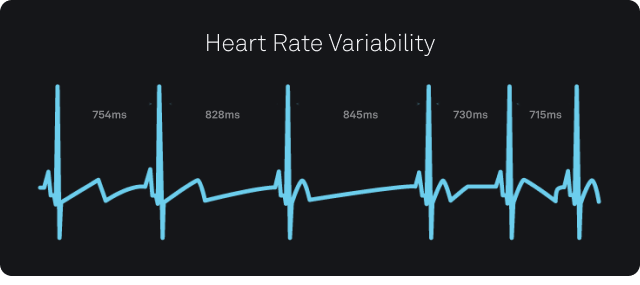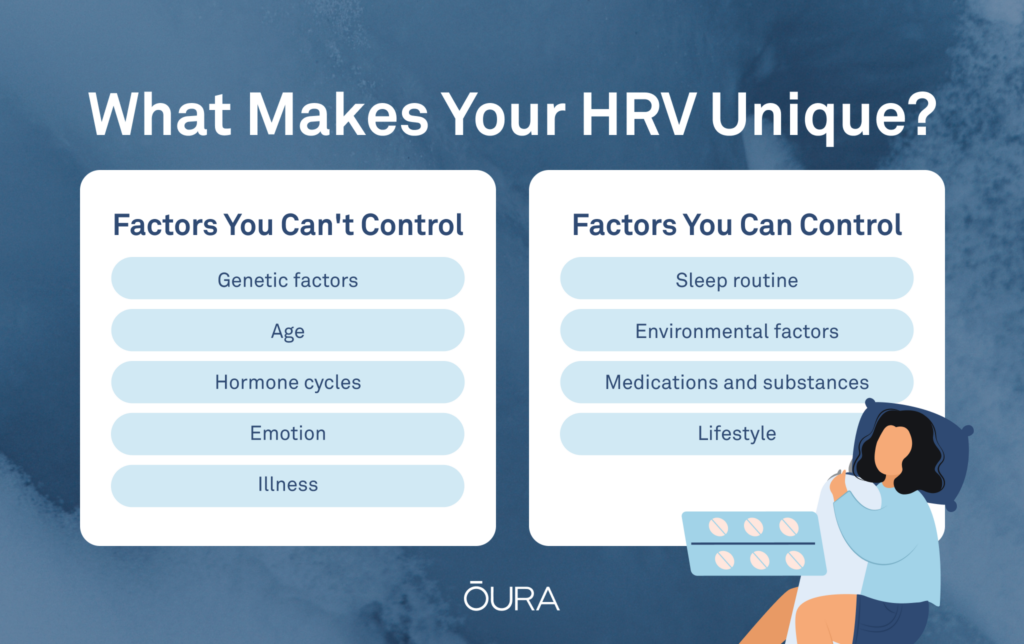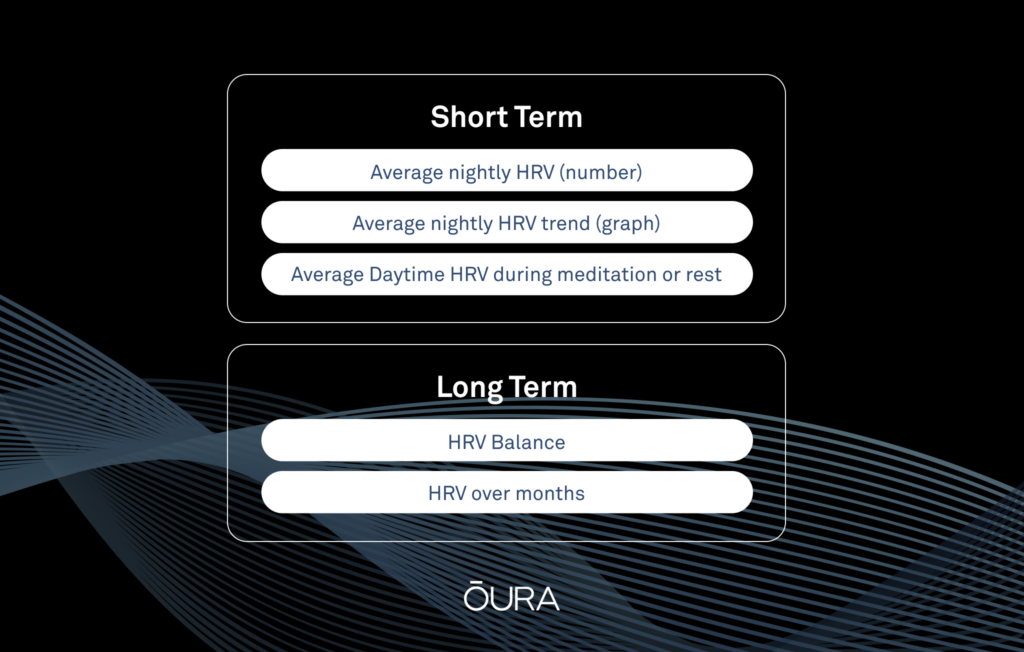As popular as the metaphor may be, a healthy heart doesn’t beat as regularly as a metronome — in fact, it changes its rhythm with each beat. This constant variation in milliseconds between your heartbeats is known as your heart rate variability, or HRV.
Some situations increase variation (high HRV), while others cause the time intervals between beats to stay more constant (low HRV).

You may be unaware of these subtle variations, but they reflect your heart’s ability to respond to different situations. HRV can react to stress and/or illness before resting heart rate (RHR), which makes it one of your body’s most powerful signals — providing useful insights into your stress levels, recovery status, and general well-being.
| Member Tip: Wondering what your normal heart rate variability is? Oura members can discover their HRV and learn how it fluctuates by monitoring HRV balance, which contributes to your Readiness Score. A good HRV score is a sign that your body can adapt to stress and recover from challenges. |
READ MORE: How Accurate Are Oura’s Heart Rate & HRV Measurements?
What is Heart Rate Variability (HRV)?
HRV is linked to your autonomic nervous system (ANS) and the balance between the parasympathetic nervous system (PNS or rest-and-digest branch) and the sympathetic nervous system (SNS or fight-or-flight branch). By balancing the two forces, the ANS helps you respond to daily stressors and regulate some of your body’s most important systems, including heart rate, respiration, and digestion.
HRV is the most effective way of estimating your ANS balance, as it directly impacts your heart’s activity.
Independently, your heart beats to its own rhythm thanks to a built-in pacemaker called the sinoatrial (SA) node. Your SA keeps your heart firing at around 100 beats per minute.
However, your ANS greatly influences how your heart beats. All the cells within your heart’s pacemaker have direct phone lines from both sides of your ANS. They give input, beat to beat, on a cellular level to your heart:
- Your rest-and-digest tells your heart to slow down, making room for variability between beats (higher HRV)
- Your fight-or-flight system tells your heart to speed up, limiting space for variability (lower HRV)
These two systems can be silent, active, or shouting over each other at any given time. That’s a lot of conversation, and it leads to a lot of variation.
As a rule of thumb:
- Higher HRV is associated with rest-and-digest, general fitness, and good recovery
- Lower HRV is associated with fight-or-flight responses, stress, illness, or overtraining
HRV ms is the measurement of your HRV, expressed in milliseconds.
Is HRV Unique to You?
“High” and “low” heart rate variability is relative for each person. You will have your own heart rate variability range. It’s a highly sensitive and unique metric.
Some individuals have steady HRV scores, while others fluctuate considerably. HRV is an evolving tool, which means, at every HRV level, your personal scores and body status observations are especially important.
Each person’s HRV is unique, so compare your HRV to your own averages and avoid comparisons to others. It’s normal to see daily and seasonal fluctuations in your HRV.
Keep in mind that many factors impact your ANS and, therefore, your HRV.

Factors You Can’t Control
- Genetic factors: Your genetic makeup plays a significant role in determining your baseline HRV. Variations in genes mean you have a unique autonomic nervous system, which leads to individual differences in HRV patterns. As a result, you may naturally have higher or lower HRV. While you can’t change your genetic predispositions, it can help you to understand your HRV baseline.
- Age: HRV changes with age. Generally, HRV tends to decrease as you get older. This decline is attributed to various age-related changes in the autonomic nervous system and heart function. Nonetheless, even within specific age groups, individual differences in HRV exist.
- Hormone cycles: Hormone cycles, particularly in women, can influence HRV. Menstrual cycles and fluctuations in sex hormones like estrogen and progesterone can affect the autonomic nervous system and, consequently, HRV. Changes in HRV during different phases of the menstrual cycle are not uncommon.
- Emotion: Positive emotions and relaxation have been shown to increase HRV, indicating a more flexible and adaptive autonomic nervous system. Conversely, anxiety and stress can lower HRV, indicating a less resilient autonomic response.
Member Tip: In Explore content in the Oura App, you can access guided and unguided meditation and mindfulness content to help promote emotional balance and improve HRV. - Illness: Certain illnesses and health problems, like cardiovascular diseases, diabetes, high blood pressure, or respiratory disorders, can impact HRV. During illness, HRV may decrease due to the body’s response to physiological stress.
READ MORE: HRV and Stress: What HRV Can Tell You About Your Mental Health
Factors You Can Control
- Sleep routine: Your internal biological rhythms, such as circadian rhythm and sleep-wake cycle, can affect HRV. For example, a sleep-wake cycle that promotes adequate and restful sleep can result in better HRV, while sleep disturbances and sleep deprivation can lead to decreased HRV. The good news is that you can align your lifestyle with your body’s natural rhythm to enhance your sleep routine and, in turn, HRV.
| Member Tip: You can find out your chronotype (whether you’re a morning or night person) in the Oura App using the Body Clock and Chronotype feature. This makes it easier to align your lifestyle with your body’s rhythm and fall into a better sleep routine. |
- Environmental factors: Environmental factors, such as air quality, temperature, and altitude, can influence HRV.
- Medications and substances: Various medications and substances can influence the autonomic nervous system and, consequently, HRV. For instance, stimulants like caffeine or certain drugs may increase sympathetic activity and reduce HRV.
- Lifestyle: Your lifestyle choices, including your physical activity, sleep quality, stress management, as well as hydration, and dietary habits, all contribute to your distinct HRV patterns. This means that you have some control over your HRV balance.
| Member Story: Using the Oura App, Jussi L. noticed that alcohol consumption negatively affected his sleep quality and HRV. “When I had a glass of wine I’d fall asleep quickly, but the quality of my sleep was horrible, and my HRV plummeted.” The app then provided insights that enabled Jussi to adjust his diet and evening routine, leading to a better HRV. “When making all these changes, my Oura stats started to improve. My HRV soared to 60 for a period, which for my age is terrific, and now hovers around 40,” he adds. |
RELATED: Using Oura To Understand Your Body
What is a Good Heart Rate Variability (HRV)?
A normal HRV for adults can range anywhere from below 20 to over 200 milliseconds.* The best way to determine your HRV normal range is to use a wearable that measures your HRV in a controlled setting, like sleep, and establishes a baseline over a few weeks.
Curious how other Oura members’ HRV scores stack up? We took a look at our community data, and found a range of normal HRV scores across Oura members, revealing interesting trends across age and gender. Head to this blog to learn more about Oura members’ average HRV.
How Long Does it Take to Improve Your HRV?
Because HRV is so responsive, there are multiple touchpoints where it can provide insights. Helpful short- and long-term metrics to track include average daytime and nightly HRV, as well as HRV Balance and HRV over months.

Each metric provides different insights.
- How your nightly average HRV compares to your baseline, and whether it trends up or down, can help you know how to approach your day (e.g., prioritizing rest or facing a challenge).
- Comparing your daytime check-ins to your general baseline can give you insight into how certain activities, like meditation or exercise, affect your system.
- How your HRV trends over a few weeks, your HRV balance, can help you identify if you’re successfully rebounding from taxing days (e.g., training, illness, stress).
- How your HRV changes over months can reveal how major lifestyle changes (e.g., a new job, becoming a parent) are impacting your health.
Is It Normal For HRV to Fluctuate?
Some explanations of HRV oversimplify it by asserting that a high number is always good and a low one is always bad. It’s far more complex.
While high HRV is generally positive, there are situations where low HRV is necessary and even desirable. For example, during strenuous exercise, low heart rate variability is a reflection of your fight-or-flight system appropriately dominating to get your heart rate up for activity. Your HRV will rebound afterward, as your rest-and-digest system takes over to help you recover.
These fluctuations occur throughout the day, as different daily stressors continuously challenge your system. Simply being excited or moving from the couch to the bathroom can change your HRV at any given moment.
By measuring your HRV during the day, you’re capturing your body’s response to these fleeting changes. If you want to understand your chronic physiological state, the best time to measure HRV is while you sleep.
At night, your body is in a consistent state, without any confounding variables (e.g., food, social interactions, changing environment). Some wearables take the apples-to-apples approach when it comes to your measurements. They fail to caveat that daytime measurements might mask your underlying ANS balance.
Which Patterns Matter?
Monitoring your HRV can help you reach peak productivity, manage stress, and fine-tune your training regimen.
A single nightly HRV reading can provide insights, like:
- A higher HRV score that reflects a rest day, cool bedroom, or “mindful” low/moderate intensity activities such as hiking or yoga
- A lower HRV score that results from dehydration, alcohol, late meal or exercise, illness, a high-intensity workout, acute stress, or a hot bedroom
You may notice that your HRV varies greatly from day to day. If you’re looking for patterns, what matters is your HRV trend.
READ MORE: How To Increase Your HRV (Heart Rate Variability)

Key Takeaways
Your heart’s rhythm constantly changes, and this variation, or heart rate variability (HRV), is a powerful signal of your body’s stress and recovery. A high HRV suggests you’re well-rested and recovered, while a low HRV can signal stress or fatigue.
Frequently Asked Questions
What’s HRV?
HRV meaning the natural, millisecond-by-millisecond variation in the time between your heartbeats. It’s a key indicator of your nervous system’s balance, showing how well your body adapts to stress and recovers.
What is HRV ms?
HRV ms is simply the measurement of your heart rate variability and the number you see is expressed in milliseconds (ms). It reflects the tiny, healthy differences in time between each of your heartbeats.
What’s a good HRV?
There’s no single “good” HRV score since it’s highly personal. Healthy HRV levels can range widely from person to person. The most important thing is to track your own average over time. But if you’re wondering what HRV is good or what is a healthy HRV, know that generally speaking, a higher HRV indicates a state of rest and recovery, while a lower HRV can signal stress, illness, or fatigue.
What is a normal heart rate variability?
Normal heart rate variability can range from under 20 to over 200 milliseconds. That said, if your HRV is 18 ms, it doesn’t necessarily signal an alarm. The average HRV across all members is 41 ms, but HRV ranges and changes on a day-to-day basis. As this chart shows, HRV tends to be much higher for younger people than older people. But remember: if you’re wondering what should heart rate variability be, remember that it’s highly individualized.
LEARN MORE: What Is the Average HRV?
What is an HRV score?
Oura measures your heart rate variability while sleeping. Each morning when you open the Oura App, you will see your average HRV while sleeping. On Oura, this is known as your Oura HRV score, but beyond Oura, you may also see it referred to as your HRV level or your HRV status.
What factors affect my HRV?
Many factors influence your HRV, including those you can’t control, like genetics, age, and hormone cycles. However, you can positively impact your HRV through healthy habits. Getting enough quality sleep, managing stress, exercising regularly, and staying hydrated all contribute to a healthier HRV.
Why does my HRV fluctuate?
It’s completely normal for your HRV to fluctuate throughout the day and from one day to the next. These changes are a reflection of your body’s natural response to different activities and stressors. For example, your HRV will drop during intense exercise and then rebound as your body recovers.




